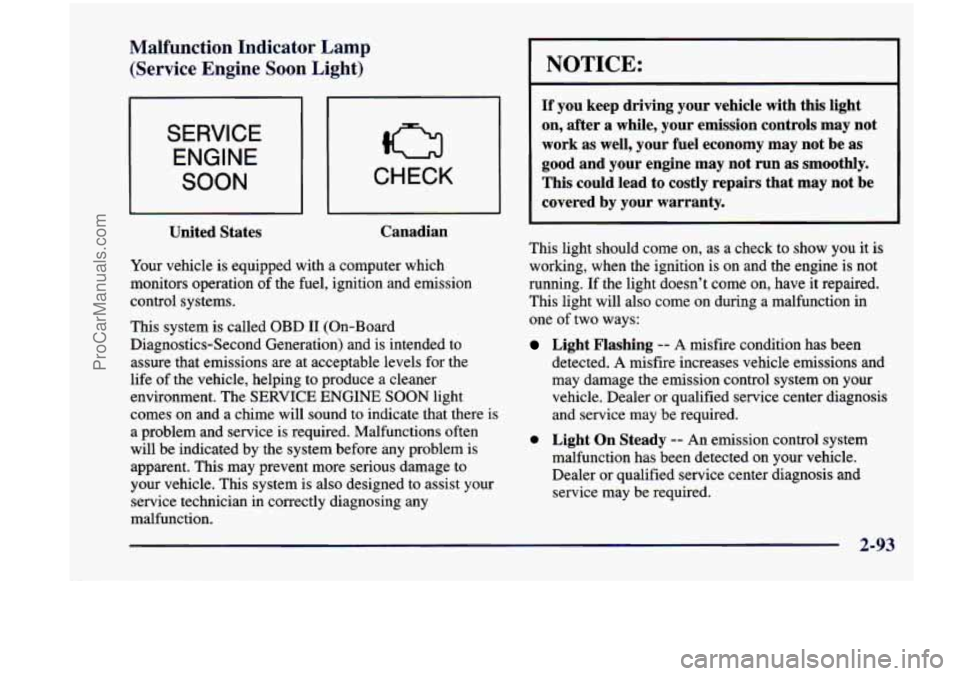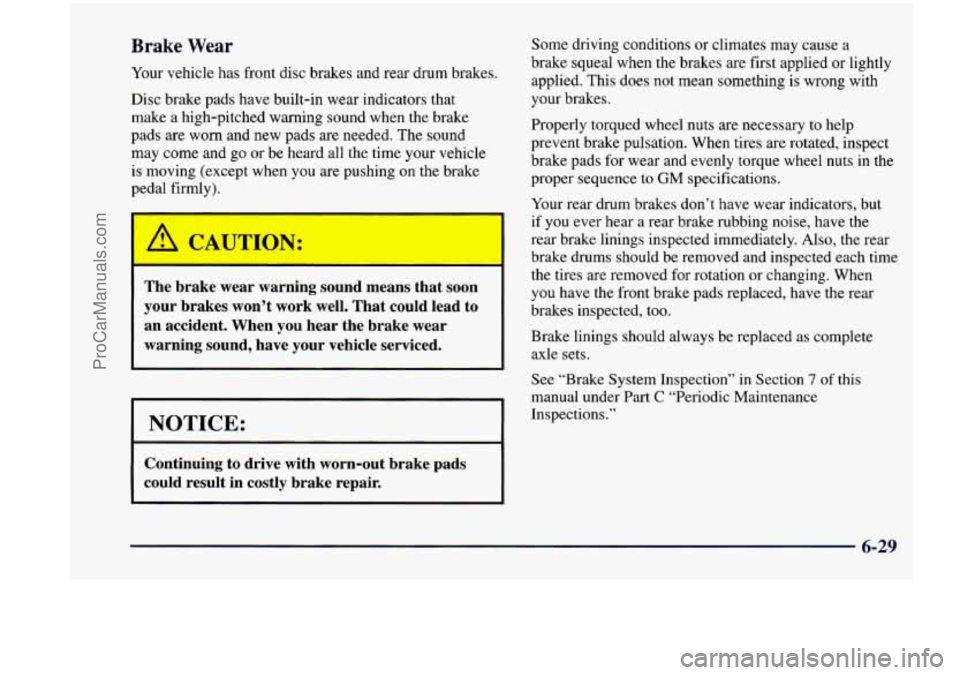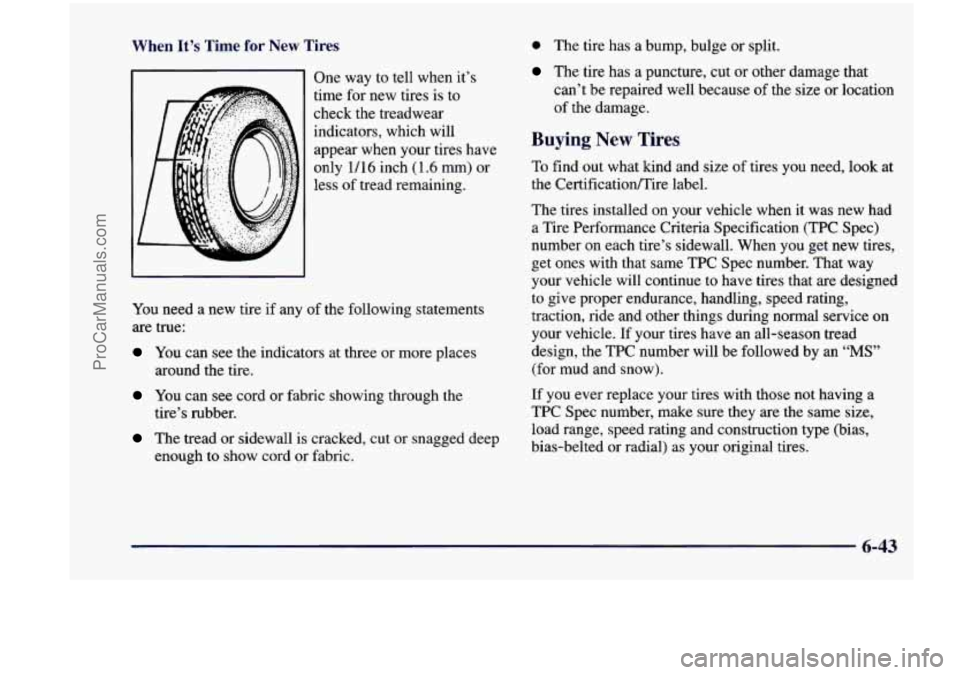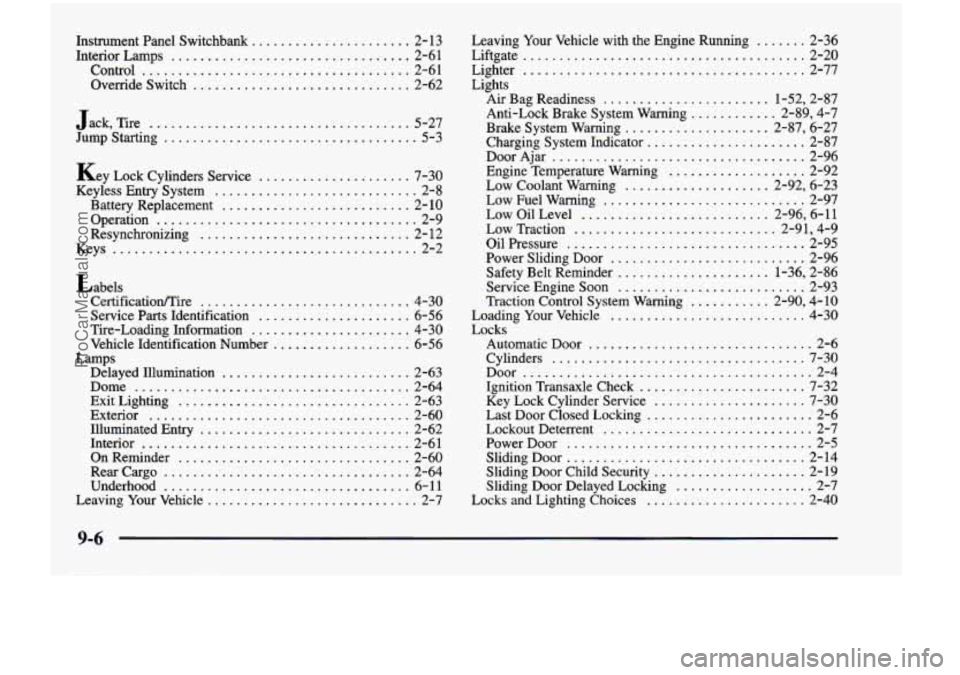1998 CHEVROLET VENTURE service indicator
[x] Cancel search: service indicatorPage 204 of 474

Air Bag Readiness Light
There is an air bag readiness light on the instrument
panel, which shows
a deployed air bag. The system
checks the air bag’s electrical system for malfunctions.
The light tells you if there is an electrical problem.
The system check includes the air bag sensors, the air
bag module, the wiring and the diagnostic module. For
more information on
the air bag system, see “Air Bag”
in the Index.
This light will come on
when you start your engine,
and
it will flash for a few
seconds. Then the light
should go out. This means
the system is ready.
If the air bag readiness light stays on after you start the
engine or comes on when you are driving, your air bag
system may not work properly. Have your vehicle
serviced right away.
The air bag readiness light should flash for
a few
seconds when you turn the ignition key to
RUN. If the
light doesn’t come on then, have it fixed
so it will be
ready to warn you
if there is a problem.
Charging System Indicator Light
1+1
The charging system light
will come on when you turn
on the ignition as a check to
show you it is working. It
will remain on as long as
the engine is not running.
It should go out once the engine is running. If
it stays
on, or comes on while you are driving, you may have a
problem with the charging system. It could indicate that
you have problems with a generator
drive belt, or
another electrical problem. Have
it checked right away.
Driving while this light
is on could drain your battery.
If you must drive a short distance with the light
on, be
certain to turn off all your accessories, such as the radio
and air conditioner.
Brake System Warning Light
When the ignition is on, the brake system warning light
will come on when you set your parking brake. The light
will stay on if your parking brake doesn’t release fully.
If it stays on after your parking brake is fully released, it
means you have a brake problem.
2-87
ProCarManuals.com
Page 210 of 474

Malfunction Indicator Lamp (Service Engine Soon
Light)
SERVICE
ENGINE
SOON CHECK
United States Canadian
Your
vehicle is equipped with a computer which
monitors operation of the fuel, ignition and emission
control systems.
This system is called OBD
I1 (On-Board
Diagnostics-Second Generation) and is intended to
assure that emissions are at acceptable levels for the
life of the vehicle, helping to produce a cleaner
environment. The SERVICE ENGINE SOON light
comes on and a chime will sound to indicate that there is
a problem and service is required. Malfunctions often
will be indicated by the system before any problem is
apparent. This may prevent more serious damage to
your vehicle. This system
is also designed to assist your
service technician in correctly diagnosing any
malfunction.
NOTICE:
If you keep driving your vehicle with this light
on, after a while, your emission controls may not
work as well, your fuel economy may not be as
good and your engine may not run as smoothly.
This could lead to costly repairs that may not be
covered by your warranty.
This light should come on, as a check to show you it is
working, when the ignition is on and the engine is not
running.
If the light doesn't come on, have it repaired.
This light will also come on during a malfunction in
one of two ways:
Light Flashing -- A misfire condition has been
detected.
A misfire increases vehicle emissions and
may damage the emission control system on your
vehicle. Dealer or qualified service center diagnosis
and service may be required.
0 Light On Steady -- An emission control system
malfunction has been detected on your vehicle.
Dealer or qualified service center diagnosis and
service may be required.
2-93
ProCarManuals.com
Page 250 of 474

If your vehicle is equipped with the AM-FM Stereo with
Cassette Tape Player and Automatic Tone Control:
1. Turn the ignition to RUN or ACCESSORY.
2. Turn the radio off.
3. Press and hold the TAPE AUX button for five
seconds. The tape symbol on the display will flash
for two seconds.
4. Insert the scrubbing action cleaning cassette.
5. Eject the cleaning cassette after the manufacturer’s
recommended cleaning time.
When the cleaning cassette has been ejected, the cut tape detection feature is active again.
You may also choose a non-scrubbing action, wet-type
cleaner which uses a cassette with a fabric belt to clean
the tape head. This type of cleaning cassette will not
eject on its own.
A non-scrubbing action cleaner may
not clean as thoroughly as the scrubbing type cleaner.
The use of
a non-scrubbing action, dry-type cleaning
cassette is not recommended. After you clean the player, press and hold EJECT
for
five seconds to reset the CLN indicator. The radio will
display
--- to show the indicator was reset.
Cassettes are subject to wear and the sound quality may degrade over time. Always make sure
the cassette
tape is
in good condition before you have your tape
player serviced.
Care of Your Compact Discs
Handle discs carefully. Store them in their original cases
or other protective cases and away from direct sunlight
and dust. If the surface of a disc is soiled, dampen a
clean, soft cloth
in a mild, neutral detergent solution and
clean
it, wiping from the center to the edge.
Be sure never to touch the signal surface when handling
discs. Pick up discs by grasping the outer edges or the
edge of the hole and the outer edge.
3-31
ProCarManuals.com
Page 339 of 474

If your vehicle is certified to meet California Emission
Standards (indicated on the underhood emission control
label),
it is designed to operate on fuels that meet
California specifications. If such fuels are not available
in states adopting California emissions standards, your
vehicle will operate satisfactorily on fuels meeting
federal specifications, but emission control system
performance may be affected. The malfunction indicator
lamp on your instrument panel may turn on and/or your
vehicle may fail a smog-check test. If
this occurs, return
to your authorized Chevrolet dealer for diagnosis to
determine the cause of failure. In the event it is
determined that the cause of the condition is the type
of
fuels used, repairs may not be covered by your warranty.
Some gasolines that are not reformulated for low
emissions contain an octane-enhancing additive called
methylcyclopentadienyl manganese tricarbonyl
(MMT);
ask your service station operator whether or not his fuel
contains MMT. General Motors does not recommend the
use of such gasolines. If fuels containing
MMT are used,
spark plug life may be reduced and your emission
control system performance may be affected. The
malfunction indicator lamp on your instrument panel
may turn on.
If this occurs, return to your authorized
Chevrolet dealer for service.
To provide cleaner air, all gasolines in the United States
are now required to contain additives that will help
prevent deposits from forming in your engine and fuel
system, allowing your emission control system to
function properly. Therefore, you should not have to
add anything to the fuel. In addition, gasolines
containing oxygenates, such as ethers and ethanol, and
reformulated gasolines may be available in your area to
help clean the air. General Motors recommends that you
use these gasolines
if they comply with the
specifications described earlier.
NOTICE:
Your vehicle was not designed for fuel that
contains methanol. Don’t use it. It can corrode
metal parts in your fuel system and also damage
plastic and rubber parts. That damage wouldn’t
be covered under your warranty.
6-4
ProCarManuals.com
Page 364 of 474

Brake Wear
Your vehicle has front disc brakes and rear drum brakes.
Disc brake pads have built-in wear indicators that
make a high-pitched warning sound when the brake
pads are
worn and new pads are needed. The sound
may come and
go or be heard all the time your vehicle
is moving (except when you are pushing on the brake
pedal firmly).
A CAUTION:
The brake wear warning sound means that soon
your brakes won’t work well. That could lead to
an accident. When you hear the brake wear
warning sound, have your vehicle serviced.
NOTICE:
Continuing to drive with worn-out brake pads
could result in costly brake repair.
Some driving conditions or climates may cause a
brake squeal when the brakes are first applied or lightly
applied. This does not mean something is wrong with
your brakes.
Properly torqued wheel nuts are necessary
to help
prevent brake pulsation. When tires are rotated, inspect
brake pads for wear and evenly torque wheel nuts
in the
proper sequence
to GM specifications.
Your rear drum brakes don’t have wear indicators, but
if you ever hear a rear brake rubbing noise, have the
rear brake linings inspected immediately. Also, the rear
brake drums should be removed and inspected each time
the tires are removed
for rotation or changing. When
you have the front brake pads replaced, have the rear
brakes inspected,
too.
Brake linings should always be replaced as complete
axle sets.
See “Brake System Inspection” in Section 7 of this
manual under
Part C “Periodic Maintenance
Inspections.”
6-29
ProCarManuals.com
Page 378 of 474

When It’s Time for New Tires
11 One way to tell when it’s
time for new tires is to
check the treadwear
indicators, which will
appear when your tires have
only
1/16 inch (1.6 mm) or
less
of tread remaining.
0 The tire has a bump, bulge or split.
The tire has a puncture, cut or other damage that
can’t be repaired well because of the size or location
of the damage.
Buying New Tires
To find out what kind and size of tires you need, look at
the Certificatioflire label.
You need a new tire if any
of the following statements
are true:
You can see the indicators at three or more places
around the tire.
You can see cord or fabric showing through the
tire’s rubber.
The tread or sidewall is cracked, cut or snagged deep
enough
to show cord or fabric. The
tires installed on your vehicle when it was new had
a Tire Performance Criteria Specification (TPC Spec)
number on each tire’s sidewall. When you get new tires,
get ones with that same TPC Spec number. That way
your vehicle will continue to have tires that
are designed
to give proper endurance, handling, speed rating,
traction, ride and other things during normal service on
your vehicle. If your tires have an all-season tread
design, the TPC number will be followed by an
“MS”
(for mud and snow).
If you ever replace your tires with those not having
a
TPC Spec number, make sure they are the same size,
load range, speed rating and construction type (bias,
bias-belted or radial) as your original tires.
ProCarManuals.com
Page 459 of 474

1
Brake Adjustment
.................................. 6-30
Fluid
....................................... 6-26
Master Cylinder
.............................. 6-26
Parking
..................................... 2-34
PedalTravel
................................. 6-30
Replacing System Parts
........................ 6-30
System Warning Light
.................... 2-87. 6-27
Trailer
...................................... 4-37
Transaxle Shift Interlock
....................... 2-37
Transaxle Shift Interlock Check
.................. 7-3 1
Wear ....................................... 6-29
Brakes. Anti-Lock
............................... 4-7
Braking
........................................ 4-6
Braking in Emergencies
.......................... 4-10
Break-In, New Vehicle
.......................... 2-25
BTSI
......................................... 2-37
BTSICheck
................................... 7-31
Bucketseats
................................... 1-26
Adjusting
................................... 1-27
Folding or Reclining the Seatbacks
............... 1-26
Removing
................................... 1-28
Bulb Replacement
.............................. 6-3 1
Replacing
................................... 1-30
Canadian Roadside Assistance
.................... 8-7
Capacities and Specifications
...................... 6-65
Captain’s Chairs
................................ 1-33
Removing
................................... 1-33
Replacing
................................... 1-34
Carbon Monoxide
.................... 2.38.4.29. 4.37
CargoNet
..................................... 2-72 Cassette Deck Service
........................... 7-29
Cassette Tape Player
....................... 3-12. 3-15
Cassette Tape Player Care
........................ 3-30
CD Adapter Kits
.......................... 3-14. 3-19
CD Player Theft-Deterrent Feature
................. 3-26
Center Dome Lamp
............................. 2-64
Center Rear Passenger Position (Bench Seat)
......... 1-64
Center Rear Passenger Position (Bucket Seat)
......... 1-66
Certificatioflire Label
.......................... 4-30
Chains. Safety
................................. 4-37
Chains. Tire
................................... 6-47
Changing a Flat Tire
............................. 5-24
Charging System Indicator Light
................... 2-87
Checking Your Restraint Systems
................. 1-101
Chemical Paint Spotting
.......................... 6-54
Children
...................................... 1-68
Child Restraints
................................ 1-82
Built-in
..................................... 1-71
Cleaning Built-in
............................. 6-50
Securing in a Rear Outside Seat Position
........... 1-89
(Bucketseat)
............................... 1-93
(Third Row Bench Seat)
...................... 1-91
Securing in the Right Front Seat Position
.......... 1-95
TopStrap
................................... 1-88
Where to Put
........................... 1-86. 1-87
Cigarette Lighter
............................... 2-77
Circuit Breakers and Fuses
....................... 6-58
Cleaner. Air
................................... 6-15
Cleaning Aluminum Wheels
............................ 6-53
Built-in Child Restraint
........................ 6-50
Fabric
...................................... 6-49
Securing in the Center Rear Seat Position
Securing in the Center Rear Seat Position
9-2
ProCarManuals.com
Page 463 of 474

Instrument Panel Switchbank ...................... 2- 13
Interior Lamps ................................. 2-61
Control
..................................... 2-6 1
Override Switch .............................. 2-62
Jack. Tire
.................................... 5-27
Jump Starting
................................... 5-3
Key Lock Cylinders Service
..................... 7-30
Keyless Entry System
............................ 2-8
Battery Replacement
.......................... 2-10
Operation
.................................... 2-9
Resynchronizing
............................. 2- 12
Keys
.......................................... 2-2
Labels CertificatiodTire
............................. 4-30
Service
Parts Identification ..................... 6-56
Tire-Loading Information
...................... 4-30
Vehicle Identification Number
................... 6-56
Delayed Illumination
.......................... 2-63
Dome
...................................... 2-64
Exit Lighting
................................ 2-63
Exterior
.................................... 2-60
Illuminated Entry
............................. 2-62
Interior
..................................... 2-61
OnReminder
................................ 2-60
Rearcargo
.................................. 2-64
Underhood
.................................. 6-11
Leaving Your Vehicle
............................. 2-7
Lamps
Leaving Your Vehicle with the Engine Running ....... 2-36
Liftgate
....................................... 2-20
Lights Lighter
....................................... 2-77
Air Bag Readiness
....................... 1.52. 2.87
Anti-Lock Brake System Warning
............ 2.89. 4.7
Brake System Warning .................... 2.87. 6.27
Charging System Indicator
...................... 2-87
DoorAjar
................................... 2-96
Engine Temperature Warning
................... 2-92
Low Coolant Warning
.................... 2-92, 6-23
Low Fuel Warning
............................ 2-97
Low Oil Level
.......................... 2-96, 6-11
Low Traction
............................ 2-91, 4-9
Oil Pressure ................................. 2-95
Power Sliding Door
........................... 2-96
Safety Belt Reminder
..................... 1-36, 2-86
Service Engine
Soon .......................... 2-93
Traction Control System Warning
........... 2-90, 4-10
Loading Your Vehicle
........................... 4-30
Locks
Automatic Door
............................... 2-6
Cylinders
................................... 7-30
Door
........................................ 2-4
Ignition Transaxle Check
....................... 7-32
Key Lock Cylinder Service
..................... 7-30
Lockout Deterrent
............................. 2-7
PowerDoor
.................................. 2-5
Sliding Door Child Security
..................... 2-19
Sliding Door Delayed Locking
................... 2-7
Locks
and Lighting Choices ...................... 2-40
Last Door Closed Locking
....................... 2-6
Sliding Door
................................. 2-14
9-6
. _._-___- .
ProCarManuals.com